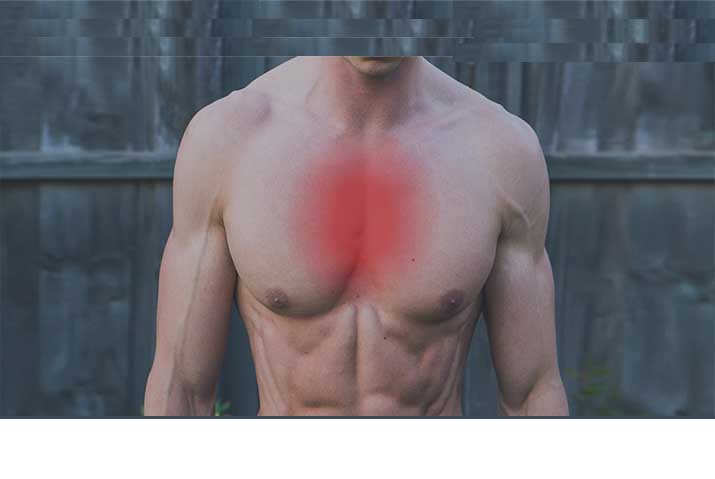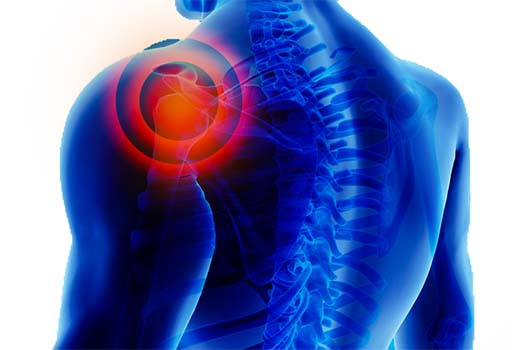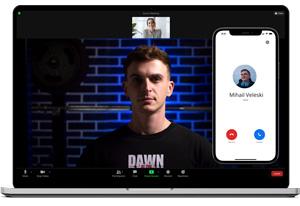Not all people suffering from the pectus excavatum condition feel pain. However, in severe cases of deformity, agony is prevalent. The pain can worsen if the deformity worsens.
The pain motivated me. I felt it in my chest and back area, and I had a lot of sleepless nights because of it. I was more motivated by the pain than the pleasure of having a muscular and appealing upper body.

6 SYMPTOMS OF PECTUS EXCAVATUM ACHE
You will generally feel the pain caused by pectus excavatum in six different areas.
- Chest
- Back
- Ribs
- Stomach
- Shoulders
- Spine

Most physicians aren't aware that the funnel chest deformity is a reason for pain in areas other than the chest and back. I suffered from the spine, back, and stomach aches.
I thought it was caused by my pectus excavatum because there wasn't any other logical reason for the source of the pain, so I went to the specialist.
He wasn't sure where the pain came from. He told me I had food poisoning despite my rigorous and clean diet. The stomach pain was weird. It was something that I hadn't experienced before.
However, at the time, my posture was in the worst condition of my life because of playing video games for more than ten hours a day. Playing World of Warcraft, DOTA, and Conquer Online took a toll on my health.
My pectus excavatum got worse because of my bad posture and scoliosis. After going home, I read about the most common pectus excavatum pain symptoms.
I noticed that I experienced every single pain associated with the deformity. That is when everything clicked and made sense to me.
Pectus excavatum caused pain throughout my entire body. Please learn from the mistakes I made in my teenage years. Use my story so you don't allow the deformity to damage your body and feelings.

WHAT CAUSES PECTUS EXCAVATUM PAIN?
If there is severe pectus excavatum deformity, the sternum can press against the lungs and heart. This is what causes aches and discomfort throughout the whole body. The deformity causes discomfort in the chest area, leading to sharp pain if left untreated.
The pain will make you anxious and depressed. You will have trouble concentrating on things at school or work. The worst part about the pectus excavatum agony is that it occurs when you least expect it. Sometimes a sternum crack can cause pain.
You will feel weird and horrible thinking about how the breastbone pushes against your heart and the lungs inside your chest.
Your mind-to-body connection will make the agony much worse. If you're feeling some pectus excavatum pain symptoms, please start improving your deformity.

PECTUS EXCAVATUM CHEST AGONY REASONS
There isn't any scientific evidence on what causes pectus excavatum chest pain. It is known that the pain is much worse in males than in females.
However, surgeons believe sternum compression on the lungs and heart is the exact cause. Another theory is how the pectoralis muscles cross the chest and attach to the rib cage and sternum.

HOW DOES THE PAIN FEEL
When the pectus excavatum chest pain occurs, it doesn't last a very long time. It happens unexpectedly, plenty of times throughout the day. It can be very irritating, especially while trying to fall asleep.
If the pectus excavatum dent is deep, the breastbone will press against the heart and lungs more, causing a sharper ache.
This is frequent in sufferers with Haller Index higher than 3.5. Suppose the Haller Index of your pectus excavatum is lower than 3.5. In that case, the chances of you experiencing chest pain are smaller.
BRACE HELPED ME DEAL WITH PAIN
For some strange reason, I didn't feel any chest ache whenever I wore a pectus excavatum brace. This isn't tested scientifically, but I think the reasoning is the external pressure on the abnormal chest bone.
It supports the anterior chest wall area, keeping it snug and warm. The Neo G Dorsolumbar Support brace is the best for treating chest pain.
It is made of elastic and comfortable straps that mold perfectly around the body. You'll get used to wearing that brace after just a week. You'll feel confident wearing the brace all day because the pectus excavatum chest pain won't occur throughout the day.
PECTUS EXCAVATUM AGONY IN THE BACK AREA

Just like pain in the chest, the origins of back pain caused by pectus excavatum remain unknown. The back agony caused by pectus excavatum is musculoskeletal. It is closely related to scoliosis and bad posture.
Scoliosis is a spinal condition in which the spine bends to the side. It pulls the rib cage out of the natural position and puts pressure on the muscles and bones in the back.
The pain you receive from scoliosis is mainly caused by the pressure on the spinal discs. This condition appears in most patients who suffer from hereditary pectus excavatum.
Usually, the pectus excavatum backache results in pain in the lower and upper back. It causes overall stiffness and postural weakness.
HOW TO DEAL WITH INDENTED CHEST UPPER BACK PAIN

The pectus excavatum upper back pain is usually caused by bad posture, muscle overtraining, or injury. Agony in this back area is more common than in the lower part.
The upper back ranges from the neck's base to the ribcage's lowest part. It is made of 12 bones, also known as the thoracic spine.
Slouching over in a chair in your office weakens the back muscles required for an upright posture. With time, this will worsen your pectus excavatum condition and posture, causing more pain in the upper back.
An easy way to stop pectus excavatum upper backache is to sit correctly. Also, take frequent breaks from sitting and try to do the overhead arm reach stretch.
PECTUS EXCAVATUM LOWER BACK PAIN TREATMENT

Lower back pain is more likely in sufferers aged 30 and above. The agony is related to the changes that happen to the body with aging. As you get older, the fluid between the spinal column is reduced.
Because of this, the spinal discs can experience aggravation far more easily. Also, losing some muscle tone in the lower back area because of aging makes this location prone to injury.
Strengthening the entire back musculature is very important in minimizing pectus excavatum pain. As you already know, inverted chest sufferers have limited workout capacities.
They can't work out with the same intensity or frequency as ordinary people.
EXERCISES THAT HELPED ME WITH BACK PAIN
However, if you want the pain to stay away from your back, you must do pull-ups and deadlifts. These two exercises are fantastic when it comes to improving pectus posture.
Because of this, there is an excessive strain on the muscles, tendons, ligaments, and spinal discs in the lower back area.
PECTUS EXCAVATUM SURGERY PAIN MANAGEMENT

The pain caused by a Nuss or Ravitch procedure can be very severe. The anesthesiologist places a tiny catheter (epidural) in the patient's back. It is meant to control the pain during and after the procedure.
In addition to opiates, doctors can give Toradol to some patients who suffer from severe pain.
However, this can be very harmful in some cases. Doctors must be cautious with agony management during and after post-operation.
There is the situation of 15-year-old Lewis Blackman, who died because of a post-surgical pain medication known as Toradol. It created a punctured ulcer in his stomach, which made him bleed to death.
FUNNEL CHEST PAIN AFTER SURGERY
You can feel the pain after pectus excavatum surgery while walking, taking deep abdominal breaths, and when coughing. You'll feel a sharp chest pain that needs to disappear after a week. Doctors need to be very careful with postoperative pain management.
They need to give you balanced doses of the medications. I think it is much better not to often complain about pectus excavatum pain after surgery. As soon as you complain about pain, doctors will probably give you a dose of medication.
Too much medicine can harm your health. Lewis Blackman's situation shouldn't happen ever again. Patients who underwent a long Nuss or Ravitch procedure will probably have a drainage tube in their chests as soon as they wake up.
It needs to drain excess fluid or air for a couple of days. Doctors will detach the tube throughout the hospital stay.
IS PECTUS EXCAVATUM AND STOMACH ACHE RELATED?

Two factors cause your pectus excavatum stomach pain. You'll probably experience pectus excavatum front pain while bending forward or backward. This includes sports, reading, writing on a desk, and picking an object.
The pectus excavatum deformity changes the effect of front bending. The breastbone will move backward instead of forward and cause excessive pressure on the protruding ribs.
The backward-moving pattern of the sternum, combined with the frontal flare of the abdomen, creates a crease line in the upper abdominals. It will serve as a hinge when the sufferer bends forward, putting additional pressure on the lower ribcage.
This is when the sufferer experiences pectus excavatum abdominal pain. Also, ache management medications are proven to cause stomach pain. This usually happens when the doctors give the patient a higher dosage than required.
They need to be very careful giving you the required doses. If Toradol is given in excessive amounts, it can rupture the ulcer in your stomach, causing excessive bleeding and even death.
DEALING WITH CONCAVE CHEST AND SHOULDER PAIN

Pectus excavatum is also closely related to shoulder pain. Most sufferers experience a two-sided shoulder ache (usually more severe in the right shoulder than the left one).
In extreme cases, sufferers may experience a troubled sleep cycle because of sharp shoulder agony.
If you're suffering from pectus excavatum shoulder pain, you need to increase the upper body's strength and mobility. That will minimize the ache and prevent the shoulders from getting tired quickly.
Every patient suffering from sunken chest and shoulder pain is given a set of physical therapy exercises.
That includes:
- Breathing exercises,
- Aerobic training,
- Musculoskeletal stretches,
- Strengthening exercises.
It would be best if you did the breathing and aerobic exercises 3-5 times a week. Aim for 10 minutes of breathing exercises and 10 minutes of aerobic exercises.
Your goal should be 20 minutes for each workout session. The shoulder ache will disappear with yoga, and your overall body appearance will improve.
Aim to do at least 30 minutes of full-body power yoga at least three times a week. In addition to yoga, you should also do the Superman Exercise.
It'll strengthen your posterior chain muscles, improve your posture, and decrease back and shoulder pain.
SUNKEN CHEST AND RIB ACHE

Pectus excavatum is also linked with rib pain. Most people who suffer from indented chest deformity have protruding ribs.
Even though it is a prevalent deformity, it isn't healthy and needs treatment. It is a clear sign that your core musculature is weak. If you haven't experienced pectus excavatum rib cage ache yet, you're a part of the few.
However, if you don't correct it as soon as possible, you're on your path to agony and dysfunction. When the oblique muscles in your core are strong, they keep the ribcage in a normal position.
The pectus excavatum deformity weakens these muscles. That causes the bottom of the ribs to flare up and out. This extension of the ribcage causes a lot of postural, breathing, and stabilization problems.
Also, it causes rib pain. When you have flared ribs, breathing with the diaphragm muscles becomes more difficult. The body is fighting to find a solution to get more air into the lungs.
That is when we extend our lower backs to open our abdominals and use our neck musculature. This combination causes poor posture and pain in the ribcage area.
To repair this, you need to strengthen the core as a whole and correct bad posture. Focus mainly on the internal obliques and transverse abdominal muscles.
HOW TO DEAL WITH Your KID'S PAIN

Most young patients under 12 years don't experience pectus excavatum pain and shortness of breath. The reasoning is that children's chest cartilages are still soft, flexible, and growing.
It is critically important for parents to check the posture of their kids frequently.
Usually, kids who suffer from pectus excavatum and lousy posture experience chest and back pain first. Their ache is related to their caved-in chest conditions, but they aren't aware of that.
It is your role as a parent to let the kid know that poor posture causes the growth of pain.
CONCLUSION
The occurrence of pectus excavatum pain is widespread. It happens in around 60% of all sufferers. You can mostly feel the sharp agony in the chest and back part.
If you want to get rid of pectus excavatum agony, the best way is to follow a non-surgical correction physical therapy routine. Correcting the deformity with surgical correction will only make the pain more severe.
However, if you decide to undergo surgery, please be careful with the agony management medications. An excessive amount of medicines will hurt your health.
Please read the situation of 15-year-old Lewis Blackman, who died following a Nuss procedure. He was experiencing severe pain and was given high dosages of a painkiller known as Toradol.
It caused a rupture in his abdomen, leading to bleeding to death. I advise you to start yoga and Pilates as soon as possible, whether you’re feeling a pectus excavatum chest, back, stomach, shoulder, or rib ache.
All you need is an affordable mat. Numerous scientific publications confirm that pectus excavatum can be treated effectively without surgery.
1 Source
- How To Do The Superman Exercise | Coach [Internet]. [cited 2022 Dec 1]. Available from: https://www.coachmag.co.uk/back-exercises/1726/how-to-do-the-superman-exercise














